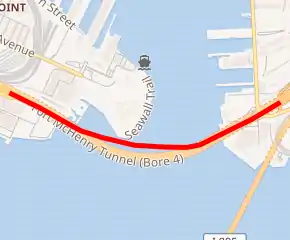Fort McHenry Tunnel
The Fort McHenry Tunnel is a four-tube, bi-directional tunnel that carries traffic on Interstate 95 (I-95) underneath the Baltimore Harbor. The lowest point in the Interstate System under water,[1] the tunnel is named for nearby Fort McHenry.
 Southbound tunnel, Bore 2 | |
| Overview | |
|---|---|
| Location | Baltimore Harbor |
| Coordinates | 39°15′39.2″N 76°34′36.3″W |
| Route | |
| Start | Locust Point |
| End | Canton |
| Operation | |
| Constructed | 1980–1985 |
| Opened | November 23, 1985 |
| Owner | Maryland Transportation Authority |
| Traffic | Automotive |
| Character | Highway |
| Toll | $4.00 |
| Vehicles per day | 115,000 |
| Technical | |
| Length | 1.5 miles (2.4 km) |
| No. of lanes | 8 lanes in 4 tubes |
| Operating speed | 55 miles per hour (89 km/h) |
| Lowest elevation | 107 feet (33 m) below harbor water surface |
| Tunnel clearance | 13.6 feet (4.1 m) |
| Width | 26 feet (7.9 m) |
| Route map | |

| |
The tunnel was constructed from May 1980 to November 1985, at a cost of about $750 million. At the time of its opening on November 23, 1985, it was the most expensive underwater tunnel project in the United States, but that figure has since been surpassed by the Big Dig project in Boston.[2]
The tunnel's annual traffic in 2009 was 43.4 million vehicles. As of July 1, 2015, the toll rate for cars is $4.00 cash or $3.00 E-ZPass, paid in either direction. Vehicles with more than two axles pay additional amounts, up to $30.00 for six axles.[3] In March 2020, all-electronic tolling was implemented as a result of the COVID-19 pandemic, with tolls payable through E-ZPass or Video Tolling, which uses automatic license plate recognition. All-electronic tolling was made permanent in August 2020.[4]
Location
The tunnel crosses the Patapsco River, just south of Fort McHenry and connects the Locust Point and Canton areas of Baltimore City.
Design and construction

Plans for a second crossing of the Baltimore Harbor that would become the Fort McHenry Tunnel began in the late 1960s. Early plans called for an 8-lane double-deck bridge to carry I-95 over the harbor just south of Fort McHenry. In 1975, plans were changed from a bridge to a tunnel when it was determined that a bridge would have detrimental impact on Fort McHenry's status as a national monument. The state of Maryland originally intended to build the tunnel with a reinforced concrete box design, but plans were changed in February 1976 to use a steel tubular design after a dispute with the Federal Highway Administration. The tunnel was to be constructed using the immersed tube method, with prefabricated tubes sunken into the harbor.[5]
Construction began in May 1980 by K-R-T (a joint venture between Peter Kiewit Sons Company, Raymond International Builders, and Tidewater Construction Corporation), and was completed in November 1985. 90 percent of construction costs were covered by federal funding, while 10 percent came from state funding. The tunnel consists of 32 tube sections, each 82 feet (25 m) wide and 42 feet (13 m) tall. The east and west approaches are 1,600 feet (490 m) and 3,200 feet (980 m) long, respectively.[6]
The opening of the tunnel closed a gap that previously existed in I-95 through Maryland.[7] The Fort McHenry Tunnel was opened on time and under its budget, and it continues to be a vital transportation link in the Mid-Atlantic region. Soon after the Fort McHenry Tunnel opened, the nearby Baltimore Harbor Tunnel, which had opened to traffic in 1957, was extensively rehabilitated.
See also
 Maryland Roads portal
Maryland Roads portal- Francis Scott Key Bridge (Baltimore)
References
- "The Interstate". Ginger Strand. Retrieved February 15, 2019.
- DCRoads.net. "Fort McHenry Tunnel: Historic Overview". Accessed 2011-07-11.
- "MdTA toll rates: Baltimore Harbor Tunnel, Fort McHenry Tunnel and Francis Scott Key Bridge". Accessed 2016-07-26.
- "All-Electronic Tolling Now Permanent at All MDTA Facilities Statewide in Maryland". Salisbury, MD: WBOC-TV. August 6, 2020. Retrieved August 6, 2020.
- Kozel, Scott M. "Fort McHenry Tunnel". Roads to the Future. Retrieved March 22, 2019.
- "Ft. McHenry Tunnel". Road Traffic Technology. Retrieved March 23, 2019.
- "The Fort McHenry Tunnel." Fact sheet.
External links
| Wikimedia Commons has media related to Fort McHenry Tunnel. |
- Fort McHenry Tunnel—history and technical info by Roads to the Future